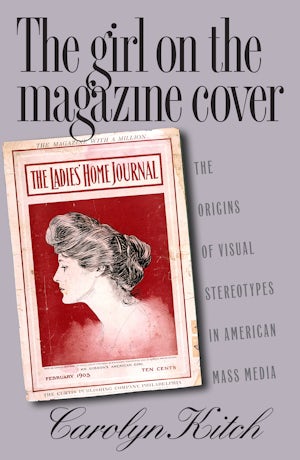The Girl on the Magazine Cover
The Origins of Visual Stereotypes in American Mass Media
By Carolyn Kitch
272 pp., 6.125 x 9.25, 75 illus, notes, bibl., index
-
Paperback ISBN: 978-0-8078-4978-1
Published: October 2001 -
E-book EPUB ISBN: 978-0-8078-9895-6
Published: November 2009 -
E-book PDF ISBN: 979-8-8908-7299-9
Published: November 2009
Buy this Book
- Paperback $42.50
- E-Book $29.99
For Professors:
Free E-Exam Copies
Awards & distinctions
A 2002 Choice Outstanding Academic Title
Kitch examines the years from 1895 to 1930 as a time when the first wave of feminism intersected with the rise of new technologies and media for the reproduction and dissemination of visual images. Access to suffrage, higher education, the professions, and contraception broadened women's opportunities, but the images found on magazine covers emphasized the role of women as consumers: suffrage was reduced to spending, sexuality to sexiness, and a collective women's movement to individual choices of personal style. In the 1920s, Kitch argues, the political prominence of the New Woman dissipated, but her visual image pervaded print media.
With seventy-five photographs of cover art by the era's most popular illustrators, The Girl on the Magazine Cover shows how these images created a visual vocabulary for understanding femininity and masculinity, as well as class status. Through this iconic process, magazines helped set cultural norms for women, for men, and for what it meant to be an American, Kitch contends.
About the Author
Carolyn Kitch is associate professor of journalism at Temple University. She is a former senior editor of Good Housekeeping and associate editor of McCall's.
For more information about Carolyn Kitch, visit
the
Author
Page.
Reviews
"Through her insightful readings of cover art from magazines . . . Kitch illuminates a fascinating and important moment in American cultural history, when national advertising combined with national magazines to articulate and commercialize a new and uniquely American sense of identity. . . . Kitch has seamlessly integrated her historical analysis of visual stereotypes with a wide range of relevant theoretical perspectives, including feminist theory, gender studies, art history, and the cultural history of advertising. . . . Kitch's analysis offers a fresh perspective on the well-worn terrain of women's service magazines."--Journalism & Mass Communication Quarterly
"Kitch's book examines a wide variety of stereotypical images of womanhood. Her copious knowledge of the publishing industry and her thought-provoking argument make this book a must-read for anyone interested in media or gender studies. This unusually well-crafted book will hold the attention of a wide audience, and belongs in all academic and public libraries."--Choice
"[An] engaging, insightful study."--Library Journal
"[A] thoughtful and eminently readable account of how women fared in this once popular form of American culture."--American Historical Review
"Through Kitch's shrewd and subtle analyses of the developing 'story' told on the covers of leading American magazines, the influential and transformative image patterns by which women were 'seen' in a variety of social roles between 1895 and 1930 are revealed in ways that are provocative, never predictable. For the study of popular culture and its symbiotic relation to feminist history, this book is a major asset."--Martha Banta, University of California, Los Angeles
"Carolyn Kitch's book represents a valuable new way of looking at and understanding the significance of images of women in mass circulation magazines. Written in a lucid, entertaining style, this work will capture the interest of general readers as well as students in women's studies and history of mass communication classes. Eye-catching illustrations add to the book's appeal and should spark provocative discussion."--Maurine Beasley, University of Maryland at College Park




